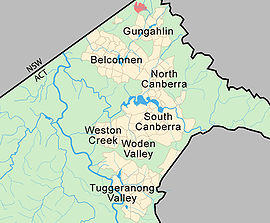Taylor, Australian Capital Territory
| Taylor Canberra, Australian Capital Territory | |||||||||||||||
|---|---|---|---|---|---|---|---|---|---|---|---|---|---|---|---|
 | |||||||||||||||
| Coordinates | 35°08′56″S 149°06′07″E / 35.149°S 149.102°E | ||||||||||||||
| Population | 2,220 (SAL 2021)[1] | ||||||||||||||
| Established | 1991 | ||||||||||||||
| Postcode(s) | 2913 | ||||||||||||||
| District | Gungahlin | ||||||||||||||
| Territory electorate(s) | Molonglo | ||||||||||||||
| Federal division(s) | Fenner | ||||||||||||||
| |||||||||||||||
Taylor is a designated suburb in Gungahlin, Canberra, Australia, though the first land release is yet to be announced. The suburb is named after magazine publisher Florence Taylor OBE, who was editor of and writer for several Australian building industry journals including the influential Building magazine. The suburb is approximately 4 km from the Gungahlin Town Centre and 16 km from the centre of Canberra and bounded by Horse Park Drive. The suburb is located in north Gungahlin near the existing suburb of Ngunnawal and adjacent to the future suburbs of Casey and Moncrieff.
History
Until 1991, the suburb aylor was part of the former 'Gold Creek' a 1,594–hectare rural property with the Gold Creek Homestead at its centre.[2]
Geology
The rocks in Taylor are from the late middle Silurian period. Hawkins volcanics green grey dacite and quartz andesite are in the west. The Canberra Formation is separated by a fault in the east side. It consists of slatey shale and mudstone, with north east trending bands of acid volcanics (dacite and andesite).[3]
References
- ^ Australian Bureau of Statistics (28 June 2022). "Taylor (suburb and locality)". Australian Census 2021 QuickStats. Retrieved 28 June 2022.
- ^ Newman Chris (2004), Gold Creek, Reflections of Canberra's Rural Heritage, Gold Creek Homestead Working Group.
- ^ Henderson, G. A. M.; Matveev, G. (1980). Geology of Canberra, Queanbeyan and Environs (Map). 1:50000.

